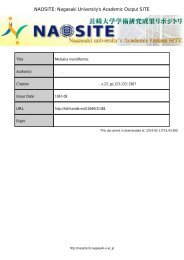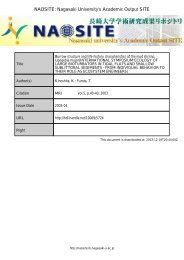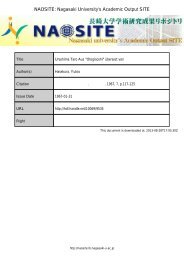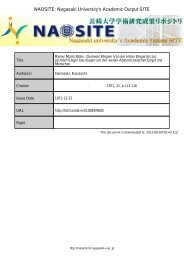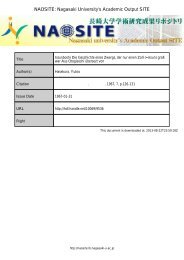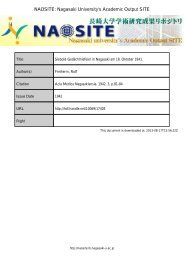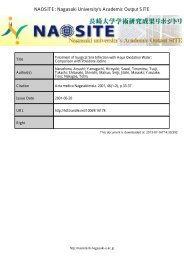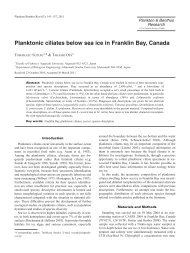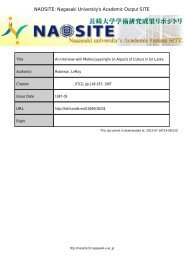Gastritis Cystica Polyposa-Report of a Case
Gastritis Cystica Polyposa-Report of a Case
Gastritis Cystica Polyposa-Report of a Case
You also want an ePaper? Increase the reach of your titles
YUMPU automatically turns print PDFs into web optimized ePapers that Google loves.
Acta Med. Nagasaki 35:29-32<br />
<strong>Gastritis</strong> <strong>Cystica</strong> <strong>Polyposa</strong>-<strong>Report</strong> <strong>of</strong> a <strong>Case</strong><br />
Tatsuo HIRANO, Hiroyuki KUSANO, Kosei MIYASHITA<br />
Daikichi OKADA, Hiroshi ISHIKAWA, Ryoji TAKAHIRA<br />
Masahiro DEGUCHI, Keizo HIRATA, Eiichiro YAMAGUCHI<br />
Naoya YAMASAKI, Kohji KISHIMOTO, Takashi TSUJI<br />
Kiyotaka KASHIMA, Hideo KIDOGAWA, Teruhisa SHIMIZU<br />
Tohru NAKAGOE, Takatoshi SHIMOYAMA, Toshio MIURA<br />
and Masao TOMITA.<br />
First Department <strong>of</strong> Surgery, Nagasaki University School <strong>of</strong> Medicine<br />
Received for publication, January 13, 1990<br />
SUMMARY : A case <strong>of</strong> gastritis cystica polyposa is presented. A 45-year-old woman<br />
developed gastritis cystica polyposa at the gastroduodenostomy anastomotic site four years<br />
after Billroth II gastrectomy for adenomatous polyp. There was no association <strong>of</strong> gastric<br />
cancer in the lesion.<br />
INTRODUCTION<br />
<strong>Gastritis</strong> cystica polyposal) (GCP) is a rare<br />
benign condition which develops at the gastrointestinal<br />
anastomotic site. Many nomenclatures<br />
were given to this condition including<br />
gastritis cystica2j, multiple polypoid cystic gastritis'),<br />
and stomal polypoid hypertrophic gastritis4>.<br />
Since Qizilbash (1975)5' and Iwashita,<br />
et al (1982)6) reported the case <strong>of</strong> an association<br />
<strong>of</strong> gastric cancer, this condition has been<br />
focused on as a premalignant condition. There<br />
hitherto has been 12 cases <strong>of</strong> such a rare<br />
coexistence <strong>of</strong> the two lesions. In this paper,<br />
a case <strong>of</strong> GCP is presented. This case had no<br />
associated cancer in the stomach. Terms<br />
appearing in this paper are used according to<br />
the general rules for the gastric cancer study<br />
in surgery and pathology in Japan').<br />
CASE REPORT<br />
A 45-year-old woman was admitted to our<br />
hospital on April 17 in 1972 because <strong>of</strong> anorexia<br />
and vomiting <strong>of</strong> eight months' duration. She<br />
lost 4kg in the last 10 months. She had<br />
undergone Billroth II gastrectomy for gastric<br />
polyps (adenomatous polyps) in 1968 at her age<br />
<strong>of</strong> 41.<br />
A stomach polyp was detected at the<br />
anastomotic site on the upper GI series and<br />
endoscopic examination in June 1970. Since that<br />
time she had been followed-up periodically.<br />
Because she developed the above symptoms and<br />
the polyp increased in size, she was readmitted<br />
to the hospital for operation. Her past history<br />
included appendectomy at 24, and her family<br />
history showed her father died <strong>of</strong> gastric cancer<br />
at her 62 years <strong>of</strong> age.<br />
Physical examination on admission was not<br />
remarkable. The previous operation scars were<br />
seen at the upper abdominal midline and the<br />
right lower quadrant. Her blood pressure was<br />
104/66 mmHg, pulse 90/minute regular, body<br />
temperature 36.6'C. Laboratory data showed<br />
RBC 408 X 104/mm3, Hb 11.8g%, Hct 37%, white<br />
blood cell count 2,700/mm3 with 1% <strong>of</strong> basophile,<br />
3% <strong>of</strong> eosinophils, 2% <strong>of</strong> bands, 44% <strong>of</strong> polymorphs,<br />
and 50% <strong>of</strong> lymphs. The platelet counts were
6.1 x 10'/mm'. The liver and renal function tests<br />
and serum electrolytes were all within normal<br />
limits, including a total protein <strong>of</strong> 6.3g%,<br />
albumin <strong>of</strong> 3.8g%.<br />
A barium swallow showed a polypoid tumor,<br />
measuring 2cm, at the greater curvature side <strong>of</strong><br />
the anastomotic site and a filling defect being<br />
1cm in width along the anastomotic site. An<br />
endoscopic examination showed three polypoid<br />
lesions at the anastomotic site.<br />
At operation (May 2, 1972), the initial operation<br />
was found to be Billroth II type gastrectomy in<br />
a retrocolic fashion with no Braun's anasto-<br />
mosis. The anastomotic site was about two<br />
times as thick as usual, and a polypoid mass<br />
was palpable at the greater curvature side. After<br />
the stomach and jejunum around the anastomotic<br />
area were resected, the gastrointestinal<br />
continuity was restored by making a Billroth<br />
Fig. 1. The resected specimen showing a polypoid<br />
lesion and a giant fold along the gastrojejunostomy<br />
anastomotic site with a finenodular<br />
surface<br />
Fig. 2. A polypoid lesion at the gastrojejunostomy<br />
site. Arrow indicates the anastomotic<br />
junction (H & E, X3.3).<br />
Fig. 3. Microscopic findings <strong>of</strong> the polypoid lesion<br />
(H & E, x 10)<br />
I anastomosis. The resected specimen showed<br />
a polypoid lesion at the greater curvature and<br />
a protruded fold <strong>of</strong> the stomach along the<br />
gastrojejunal anastornotic site (Fig. 1). The<br />
surface <strong>of</strong> the lesion was fine-nodular, similar<br />
to the brain convolution seen in the giant rugae
<strong>of</strong> Menetrier's disease. A histologic examination<br />
showed elongation <strong>of</strong> the gastric pits, hyper-<br />
plasia and cystic dilatation <strong>of</strong> the pseudopyloric<br />
glands and their submucosal invasion (Figs. 2<br />
and 3). The diagnosis <strong>of</strong> GCP was established.<br />
There was no evidence <strong>of</strong> malignancy.<br />
The patient is well and has no symptoms or<br />
signs <strong>of</strong> recurrence <strong>of</strong> GCP at the time 19 years<br />
after the second gastric resection.<br />
DISCUSSION<br />
The first case <strong>of</strong> GCP was documented in 1965<br />
by Nickolai and Muller2 as gastritis cystica.<br />
Since then the detection <strong>of</strong> these lesions has<br />
increased steadily. In Japan, the first case <strong>of</strong><br />
GCP was described by Kameyama, et al.8) in<br />
1972. GCP develops mostly in men following<br />
Billroth II gastrectomy and rarely following<br />
gastroenteric anastomosis4,9,1O) The interval<br />
from the first operation ranges from six months<br />
to 42 years').<br />
Recently GCP has been focused on as a<br />
possible precancerous lesion. To our knowledge,<br />
only three cases <strong>of</strong> GCP associated with<br />
gastric cancer have been reported in the western<br />
literature5.y.1o.11). In Japan, Iwashita documentes<br />
the first case <strong>of</strong> a coexistence <strong>of</strong> GCP and focal<br />
early carcinoma, and since then ten cases have<br />
been reported as listed in Table 1. Franzin, et<br />
a1.11) considered that GCP is a possible precan<br />
cerous lesion because <strong>of</strong> the similarties <strong>of</strong> the<br />
site and the histologic features <strong>of</strong> GCP to those<br />
<strong>of</strong> experimental stomal polyps in rats after<br />
partial gastrectomy. They stated that the most<br />
common histologic changes in case <strong>of</strong> GCP were<br />
atrophy <strong>of</strong> gastic glands, cystic dilatation <strong>of</strong><br />
gastric glands, intestinal metaplasia and<br />
dysplastic changes which occur early in the<br />
postoperative period ; and that local chronic<br />
ischemia and inflammatory reaction as a<br />
consequence <strong>of</strong> gastric surgery and suture at<br />
gastroenterostomy together with bile reflux and<br />
increase in gastric pH were responsible for the<br />
development <strong>of</strong> GCP and carcinoma. Our<br />
patient had no association <strong>of</strong> cancer. However,<br />
a special attention should be paid to the sub-<br />
sequent development <strong>of</strong> carcinoma from GCP.<br />
REFERENCES<br />
1) Littler ER, Gleibermann E : <strong>Gastritis</strong> cystica<br />
polyposa (Gastric mucosal prolapse at gastroenterostomy<br />
site, with cystic and infiltrative<br />
epithelial hyperplasia). Cancer 29: 205-9, 1972.<br />
2) Nickolai N and Muller D : Das klinische and<br />
pathologischanatomische Blid der <strong>Gastritis</strong><br />
cystica. Brum Beitr Kin Chir 210: 367-78, 1965.<br />
3) Griffel B, Engleberg M, Reiss R : Multiple<br />
polypoid cystic gastritis in old gastroenteric<br />
stoma. Arch Pathol 97:316-8, 1974.<br />
Table 1. Ten reported cases <strong>of</strong> gastritis cystica polyposa associated with cancer <strong>of</strong><br />
the stomach in the Japanese literature<br />
Year Author First Time Early gastric cancer<br />
operation interval' Type Histology Size''' Depth<br />
1982 Iwashita B-II 18y I tubs m<br />
1982 Fukuchi B-II 19y IIa tubs 2X2 m<br />
1982 Kondo B-II 19y elevated por 5X3 pin<br />
elevated tube 1.5 x 1 sm<br />
1982 Kondo B-II 21y elevated por 3.5 x 3 pin<br />
1986 Okamoto B-II 26y IIc tube 7 x 1.5 sm<br />
1987 Ishikawa B-II 16y I tubs 3.5 x 3 sm<br />
1988 Hosokawa B-II 28y I tubs 0.7 x 0.7 m<br />
1988 Hosokawa B-II 25y I tube 7X4 sm<br />
1988 Hosokawa B-II 23y IIa+IIc sig 4X3 sm<br />
1988 Lien B-II 36y IIa+IIc tube 1.6x1.5 m<br />
IIc tube 0.4 x 0.3 m<br />
* : years from the first gastrectomy, * * : centimeters, B-1: Billroth-I gastrectomy,<br />
B-II : Billroth-II gastrectomy, tubs : well differentiated adenocarcinoma, tube :<br />
moderately differentiated adenocarcinoma, por : poorly differentiated adenocarcinoma,<br />
sig : signet ring cell carcinoma, m : mucosal cancer, sm : submucosal cancer
4) Koga S, Watanabe H, Enjoji M : Stomal polypoid<br />
hypertrophic gastritis. Cancer 43 : 647-57, 1979.<br />
5) Qizilbash AH : <strong>Gastritis</strong> cystica and carcinoma<br />
arising in old gastrojejunostomy stoma. CMA<br />
Journal 112: 1432-3, 1975.<br />
6) Iwashita A, Kuroiwa S, Enjoji M, et al: Early<br />
gastric carcinoma, type I, occurring in stomal<br />
polypoid hypertrophic gastritis (SPHG). I to Cho<br />
(Stomach and Intestine) 17: 1333-9, 1982.<br />
7) Japanese Research Society for Gastric Cancer :<br />
The general rules for the gastric cancer study<br />
in surgery and pathology in Japan. Jpn j Surg<br />
11 :127-145, 1981.<br />
8) Kameyama H, Matsumori H, Takagi M, et al:<br />
Gastric polyps at the site <strong>of</strong> anastomosis after<br />
gastric resection. Surg Diag Treat 14:1504-8,<br />
1972.<br />
9) Delpre G, Kadish U, Avidor I: Incidental<br />
procurement <strong>of</strong> gastric biopsy. Endoscopy 14: 34,<br />
1982.<br />
10) Delpre G, Glanz I, Neeman A, et al: New<br />
therapeutic approach in post-operative phytobezoars.<br />
J Clin Gastroenterol 6:231-7, 1984<br />
11) Franzin G, Musola R, Zamboni G, et al.: <strong>Gastritis</strong><br />
cystica polyposa : a possible precancerous<br />
lesion. Tumori 71:13-8, 1985.



